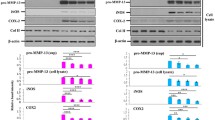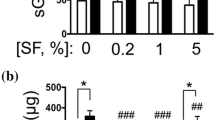Abstract
Hyaluronic acid (HA) is the main component of the extracellular matrix (ECM) of joints, and it is important for a lubricating joint during body movement. Degradation is the main metabolic process of HA in vivo. Hyaluronidases (HAase) were known for HA degradation. The inflammation-induced HA rapid-metabolism can reduce HA viscosity and concentration in joints. Mast cells (MC) containing their specific proteases were found in synovium tissue. It is unclear if MC-proteases could be involved in HA degradation pathways. This study aims to explore the correlations between HA concentration vs mast cell proteases, or matrix metalloproteinase-2/9 (MMP-2/9) and to investigate the association of MC-specific proteases with disrupted synovial HA homeostasis in rheumatoid arthritis (RA) or collagen-induced arthritis rats. The synovial fluid samples from no-RA and RA patients were collected; the collagen-induced arthritis (CIA) rat model was established; HA concentration and the activities of MC-protease and MMP-2/9 in the samples were detected, and the correlations were analyzed. In vitro interaction experiment was carried out by mixing MC-proteases with HA to observe the degradation speed. The HA concentrations in synovial fluids were decreased in RA patients and CIA rats compared with those in no-RA subjects or normal rats respectively. The activities of mast cell proteases in synovial fluids were increased and positively correlated with MMP-9, but negatively correlated with HA concentrations. In vitro study, the addition of MC-chymase and tryptase promoted the speed in HA degradation. MC-proteases may influence HA degradation pathway.




Similar content being viewed by others
Data availability
Not applicable.
References
Ahrens D, Koch AE, Pope RM, Stein-Picarella M, Michael J. Expression of matrix metalloproteinase 9 (96-kd gelatinase B) in human rheumatoid arthritis. J Arthritis Rheumatism. 2010;39(9):1576–7. https://doi.org/10.1002/art.1780390919.
Birkedal-Hansen, Henning, Susan Yamada, Jack Windsor, Anne Havemose Poulsen, and Bente. Matrix Metalloproteinases. J Current Protocols Cell Biology. 2008;Chapter 10(1):Unit 10.8. https://doi.org/10.1002/0471143030.cb1008s40.
Caughey GH. New developments in the genetics and activation of mast cell proteases. J Mol Immunol. 2002;38(16–18):1353–7.
Caughey GH. Mast cell proteases as pharmacological targets. J European J Pharmacol. 2015; 2015(778):44–55. https://doi.org/10.1016/j.ejphar.2015.04.045.
Chu, Yi, Wang April, and Xiaoying Zhou. 2019. Mast cell chymase in synovial fluid of collagen-induced-arthritis rats regulates gelatinase release and promotes synovial fibroblasts proliferation via FAK/p21 signaling pathway. Biochem Biophys Res Commun. 514. https://doi.org/10.1016/j.bbrc.2019.04.121.
Corvelli, Michael, Bernadette Che, Christopher Saeui, Anirudha Singh, and Jennifer. Biodynamic performance of hyaluronic acid versus synovial fluid of the knee in osteoarthritis. J Methods, 2015;2015(84):90-98. https://doi.org/10.1016/j.ymeth.2015.03.019.
da Silva EZ, Jamur MC, Oliver C. Mast cell function: a new vision of an old cell. J Histochem Cytochem. 2014;62(10):698–738. https://doi.org/10.1369/0022155414545334.
Silva Da, Elaine MJ, Oliver C. Mast Cell Function: a new vision of an old cell. J Histochem Cytochem. 2014;62:698–738. https://doi.org/10.1369/0022155414545334.
Fukui M, Whittlesey K, Metcalfe DD, Dastych J. Human mast cells express the hyaluronic-acid-binding isoform of CD44 and adhere to hyaluronic acid. Clin Immunol. 2000;94(3):173–8. https://doi.org/10.1006/clim.1999.4830.
Fukuishi N, Murakami S, Ohno A, Yamanaka N, Masaaki %J Journal of Immunology Akagi. . Does β-hexosaminidase function only as a degranulation indicator in mast cells? The primary role of β-hexosaminidase in mast cell granules. 2014;193(4):1886.
Gotis-Graham I, H. Patrick %J Arthritis Mcneil, and Rheumatology. . Mast cell responses in rheumatoid synovium. Association of the MCTC subset with matrix turnover and clinical progression. 2014;40(3):479–89.
Grujic, Mirjana, Aida Paivandy, Ann Marie Gustafson, Allan R. Thomsen, and Gunnar. The combined action of mast cell chymase, tryptase and carboxypeptidase A3 protects against melanoma colonization of the lung. J Oncotarget. 2017;8(15):25066-25079. https://doi.org/10.18632/oncotarget.15339.
Harada H, Takahashi M. CD44-dependent intracellular and extracellular catabolism of hyaluronic acid by hyaluronidase-1 and -2. J Biol Chem. 2007;282(8):5597–607. https://doi.org/10.1074/jbc.M608358200.
Jovanovic DV, Martel-Pelletier J, Di Battista JA, Mineau F, Pierre J. Stimulation of 92-kd gelatinase (matrix metalloproteinase 9) production by interleukin-17 in human monocyte/macrophages: a possible role in rheumatoid arthritis. J Arthritis Pelletier Rheumatol. 2000;43(5):1134–44.
Kogan Grigorij. Ladislav Soltés, Robert Stern, and Peter Hyaluronic acid: a natural biopolymer with a broad range of biomedical and industrial applications. J Biotechnology Letters Gemeiner. 2007;29(1):17–25.
Kosinska M, Ludwig T, Liebisch G, Zhang R, Siebert H-C, Wilhelm J, Kaesser U, et al. Articular joint lubricants during osteoarthritis and rheumatoid arthritis display altered levels and molecular species. PLoS ONE. 2015;10:e0125192. https://doi.org/10.1016/j.joca.2015.02.667.
Koyama, H, H Iwata, Y Kuwabara, H Iwase, S Kobayashi, and Y Fujii. Gelatinolytic activity of matrix metalloproteinase-2 and -9 in oesophageal carcinoma; a study using in situ zymography. J European J Cancer. 2000;36(16):2164–70. https://doi.org/10.1016/S0959-8049(00)00297-5.
Rodén L, Campbell P, Fraser JR, Laurent TC, Pertoft H, Thompson JN. Enzymic pathways of hyaluronan catabolism. J Ciba Found Symp. 1989;143:60–76.
Laurent TC, Dahl IMS, Dahl LB, Engstrm-Laurent A, Lilja K. The Catabolic Fate of Hyaluronic Acid. J Connective Tissue Research. 1986;15(1–2):33–41.
Leardini G, Mattara L, Franceschini M, Perbellini A. Intra-articular treatment of knee osteoarthritis. A comparative study between hyaluronic acid and 6-methyl prednisolone acetate. J Clin Perbellini Exp Rheumatol. 1991;9(4):375.
Liu X, Wang J, Chu Yi, Zhou X. Serum based fluorescent assay for evaluating dipeptidyl peptidase I activity in collagen induced arthritis rat model. Mol Cell Probes. 2017;32:5–12. https://doi.org/10.1016/j.mcp.2016.10.009.
Maharjan, Anu S., Darrell Pilling, and Richard H. High and Low Molecular Weight Hyaluronic Acid Differentially Regulate Human Fibrocyte Differentiation. J Plos One. 2011;6(10): e26078. https://doi.org/10.1371/journal.pone.0026078.
Mcnamee Kay. Richard Williams, and Michael Seed Animal models of rheumatoid arthritis: how informative are they? J Eur J Pharmacol. 2015;759:278–86.
Munaim SI, Klagsbrun M, Toole BP. Developmental changes in fibroblast growth factor in the chicken embryo limb bud. J Proceed Nat Acad Ences USA. 1988;85(21):8091–3.
Nusgens, B V %J Annales de Dermatologie et de Vénéréologie. 2010. Hyaluronic acid and extracellular matrix: a primitive molecule? 137 Suppl 1 (4):S3–8.
Quantitative measurement of serum hyaluronic acid molecular weight in rheumatoid arthritis patients and the role of hyaluronidase. J Int J Rheumatic Diseases. 2011;14(4):313–9. https://doi.org/10.1111/j.1756-185X.2011.01683.x.
Rivera J, Gilfillan A. Molecular regulation of mast cell activation. J allergy Clin.immunol. 2006;117(6):1214–25.
Sato H, Takahashi T, Ide H, Fukushima T, Yukie %J Arthritis Niwa, and Rheumatology. . Antioxidant activity of synovial fluid, hyaluronic acid, and two subcomponents of hyaluronic acid. Synovial fluid scavenging effect is enhanced in rheumatoid arthritis patients. 2014;31(1):63–71.
Shimada E, Matsumura G. Degradation process of hyaluronic acid by streptomyces hyaluronidase. J Biochem. 1980;88(4):1015–23.
Solursh M, Singley CT, Reiter RS. The influence of epithelia on cartilage and loose connective tissue formation by limb mesenchyme cultures. J Dev Biol. 1981;86(2):471–82.
Underhill C. %J Ciba Foundation symposium. The Biology of Hyaluronan. 1989;143:87–99.
Waern, Ida, Iulia Karlsson, Gunnar Pejler, Sara Wernersson. IL-6 and IL-17A degradation by mast cells is mediated by a serglycin:Serine protease axis. J Immunity, Inflammation Disease. 2016;4(1):70-79. https://doi.org/10.1002/iid3.95.
Waern Ida, Karlsson Iulia, Thorpe Michael, Schlenner Susan M, Feyerabend Thorsten B, Rodewald Hans Reimer, Abrink Magnus, Hellman Lars, Pejler Gunnar, Wernersson Sara. Mast cells limit extracellular levels of IL-13 via a serglycin proteoglycan-serine protease axis. J Biol Chem. 2012;393(12):1555–67.
Wang J, Chu Yi, Zhou X. Inhibitory effect of Triperygium wilfordii polyglucoside on dipeptidyl peptidase I in vivo and in vitro. Biomed Pharmacother. 2017;96:466–70. https://doi.org/10.1016/j.biopha.2017.09.139.
Wernersson S, Pejler G. Mast cell secretory granules: armed for battle. Nat Rev Immunol. 2014;14(7):478–94. https://doi.org/10.1038/nri3690.
West, D., Ian Hampson, Frank Arnold, and Susmitha Kumar. West DC, Hampson IN, Arnold F, Kumar SAngiogenesis induced by degradation products of hyaluronic acid. Science 228: 1324–1326. Science (New York, N.Y.) 1985 228:1324–1326. https://doi.org/10.1126/science.2408340.
Wolters PJ. Dipeptidyl peptidase I is essential for activation of mast cell chymases, but not tryptases, in mice. J Biol Chem P. 2001;276(21):18551–6.
Yi C, Guo Y, Walls AF, Zhou X. The regulatory role of dipeptidyl peptidase I on the activation of immune granulocytes. J Cell Biol Int. 2017;41(10):1093–1102. https://doi.org/10.1002/cbin.10815.
Yoshihara Y, Nakamura H, Obata K, Yamada H, Okada Y. Matrix metalloproteinases and tissue inhibitors of metalloproteinases in synovial fluids from patients with rheumatoid arthritis or osteoarthritis. J Annals Rheum Dis. 2000;59(6):455–61.
Meng Zhou, Qin Si, Chu Yang, Wang Fengming, Lu Yahua. Immunolocalization of MMP-2 and MMP-9 in human rheumatoid synovium. J Int J Clin Exp Pathol. 2014;7(6):3048–56.
Zhou, Xiaoying, Tao Wei, Christopher Cox, Andrew Walls, Yuan Jiang, and William Roche. 2019. Mast cell chymase impairs bronchial epithelium integrity by degrading cell-junction molecules of epithelial cells. Allergy:1266–1276. https://doi.org/10.1111/all.13666.
Funding
This work was supported by the Start-up Research Laboratory for Over-sea Talent Fund, China (Z391405) and Changzhou University Research Introduction Research Fund (ZMF14020066) to Prof. Xiaoying Zhou; Changzhou University Undergraduate Innovation and Entrepreneurship Fund, China (2019–02-C-96) to Yaming Guo; National Science Foundation of China (No: 81503136) to Nan Hu; and Jiangsu Province Graduate Student Scientific Research Innovation Scheme (201810292046Y) to Tao Wei.
Author information
Authors and Affiliations
Contributions
The corresponding author, Prof. Xiaoying Zhou, has made contributions to the funding, organizations, conception, design, interpretation of data, drafted/edited, and corrected the paperwork critically for intellectual content; co-first authors, Yaming Guo and Tao Wei, have made contributions to the funding, experimental works, technique operation, involved in animal model and cell model, data analysis, and preparation of the first draft and figures and corrections; Dr. Nan Hu has made contributions to experimental works, technique operation, data analysis, and drafting of corrections.
Corresponding author
Ethics declarations
Ethics approval and consent to participate
All procedures were undertaken with the approval of the Changzhou University Ethics Association (application approval number: CCZU20191022).
Consent for publication
All the authors listed have approved the manuscript.
Competing interests
The authors declare no competing interests.
Additional information
Publisher's note
Springer Nature remains neutral with regard to jurisdictional claims in published maps and institutional affiliations.
Rights and permissions
About this article
Cite this article
Guo, Y., Wei, T., Hu, N. et al. Disrupted homeostasis of synovial hyaluronic acid and its associations with synovial mast cell proteases of rheumatoid arthritis patients and collagen-induced arthritis rats. Immunol Res 69, 584–593 (2021). https://doi.org/10.1007/s12026-021-09231-2
Received:
Accepted:
Published:
Issue Date:
DOI: https://doi.org/10.1007/s12026-021-09231-2




